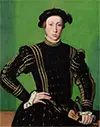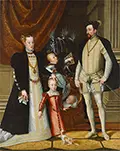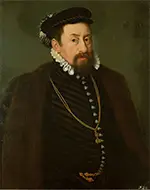Maximilian II: King of Germany, Holy Roman Emperor
Maximilian II was Holy Roman Emperor and King of Germany for a time in the mid-16th Century. 
He was born on July 31, 1527, in Vienna. His father was the eventual Holy Roman Emperor, Ferdinand I, and his mother was Anna of Bohemia and Hungary. When Maximilian was born, his father was Archduke of Austria, heir to the throne of his brother, Emperor Charles V, who had begun his time as a monarch as King Charles I of Spain. The Habsburg line was in control of the imperial throne by this time. Charles V was the head of the Spanish branch of Habsburgs, and Ferdinand headed up the Austrian branch. The rivalry had political and religious overtones, and future events would increase the rivalry. Ferdinand took the thrones of Bohemia and Hungary not long after his oldest son was born, and Maximilian grew up at the court in Innsbruck, in the Tyrol. The youngster studied in Italy and, at the age of 17, fought in the Italian Wars, fought by his uncle Charles V against France's King Francis I. 
Maximilian married when he was 18, to Maria of Spain, daughter of Charles V. They were married on Sept. 13, 1548, in Valladolid, Spain. The couple had 16 children, half of whom survived into adulthood: Anna (1549), Rudolf (1552), Ernest (1553), Elisabeth (1554), Matthias (1557), Maximilian (1558), Albert (1559), and Margaret (1567). By 1556, when Charles V abdicated his imperial throne, giving way to Ferdinand, a religious war was under way. It had been brewing for many years, and a German monk named Martin Luther had touched off a powderkeg of protest, violence, and reform in 1517. Luther and others who wanted the leaders of the Catholic Church to reform many of their practices spoke out, with their words and their actions, for decades. By the mid-1550s, Luther had begun a new religion, Lutheranism, and vastly advanced the Protestant Reformation. In the early days, Maximilian had embraced many of the teachings of these Protestants. This was a source of tension between the young Austrian and his very Catholic uncle the emperor; as well, Ferdinand, although sympathetic to some Protestant ideas, was more inclined to hew to the older faith. Ferdinand threatened to remove Maximilian from the line of succession, and the younger man put politics above conviction. 
The German electors chose Maximilian as King of Germany in 1562. He added the Hungarian crown the following year and, when his father died in 1564, became Holy Roman Emperor. Ferdinand had been emperor for only eight years; when he took the throne, he inherited less than Charles had ruled over, for that emperor had divided his lands to keep the peace, giving his oldest son, Philip II, rule over the Spanish Empire, the Netherlands, Milan, Sicily, and parts of France. Once he was on the imperial throne, Maximilian revealed his affinity for Catholic Church reform, allowing religious freedom to Lutheran nobles in Austria. He also agreed to send troops to fight against yet another Turkish invasion. The two sides battled each other for a few years more and then signed a truce, in 1568. In 1575, Maximilian got involved in a battle over the throne of Poland. Nobles there elected him king in that year, but he had little support in the country as a whole and had to resort to invasion. He was making plans for one when he died, on Oct. 12, 1576, in Regensburg. He had wisely had his oldest son, Rudolf, crowned King of Germany the year before. |
|
Social Studies for Kids
copyright 2002–2024
David White




